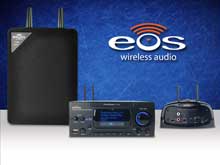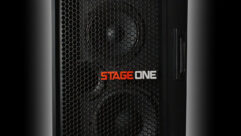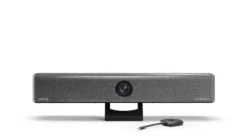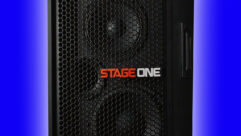

Eos Commercial Wireless Audio System Review
Nov 16, 2012 12:49 PM,
Reviewer: John McJunkin
A flexible system for applications where high SPL or sophisticated signal routing, processing, or matrix mixing are not required.
Everything is going wireless, and it’s a beautiful thing. We’ve always put up with cabling as a necessary evil in the course of delivering audio and visual communications. And cabling truly does seem evil—if a new music distribution system must be installed in an existing facility, for instance, pulling wire can be worse than pulling teeth. Until then, however, we can resolve a number of difficulties, save a lot of time, and vastly simplify processes that formerly were challenging, time-consuming, and complicated. IntelliTouch’s Eos Commercial Wireless has introduced a wireless commercial music/paging system intended primarily for applications in professional offices, spas, cafes, restaurants, and bars. I evaluated this flexible system and found it impressive.
The EOSP-500 dual zone streaming music player is the center of the system as both portal and initial source for the signals. It’s a portal in that its zone one streams music from the Internet—specifically from Cloudstream Music, which offers 50 stations covering many genres. The service covers all necessary music licensure, costs $29.95 per month, is programmed by professionals, and does not require a long-term agreement. The player is also an initial source for music as its second zone plays back music from a USB source. Zone one also features SD card backup, so if the Internet connection is lost for any reason, music is played from a user-loaded SD card. A wireless transmitter card is available for completely wireless operation, but if you won’t be operating wirelessly, you don’t have to pay for that feature. I like having features available a la carte like this.
The physical player unit is very reminiscent of car audio, with a black matte enclosure. The front panel centers on an LCD display backlit in blue. To its left are a volume knob, a momentary-contact pushbutton that toggles between music sources, a USB-A port, a power pushbutton, and a menu pushbutton. To its right are a data-entry encoder wheel surrounded by a ring that illuminates the knob in blue, along with a “back” pushbutton for navigation and volume controls for both zones, which are spring-loaded knobs that pop out and in when pressed. Finally, below the LCD display is a row of five preset buttons, along with a shift key button for access to a second bank of five presets for a total of 10.
The rear panel of the player features inputs and outputs, specifically stereo RCA outputs for the Internet stream zone and a mono RCA output for the USB/aux zone. There is an auxiliary stereo RCA input and mono RCA input for a paging microphone. Both of the stereo RCA pairs can be switched to mono with their respective slider switches. The I/O encompasses the left half of the rear panel, and the right half features a USB Mini-A port for service, an RJ-45 Ethernet port for connection to the LAN, an SD card slot, jacks for the two antennae, a DC power inlet fed by a wall wart, and LEDs to indicate status and power, and a recessed pushbutton used for linking the unit with receivers.
A lot of additional flexibility is added to the system by virtue of the EOSP-610 dual zone wireless transceiver. As implied by the name, the unit can transmit or receive signal. And while the EOSP-500 facilitates the introduction of external signals other than the Internet stream or USB/Flash audio, the EOSP-610 allows you to do the very same: plug in, transmit, and receive any signal you’d like. It’s a very simple unit with an artistic metal enclosure with black plastic end caps on the front and rear. On the front, stereo RCA outputs feed the received signal to amplification or processing, and that signal can be switched from 8Ω to 600Ω impedance with a slider on the front panel. Another slider switch toggles the unit between transmit and receive mode, and a third slider switch toggles between zones one and two. The remaining features of the front panel are a DC power inlet, LEDs to indicate power and status, and a recessed pushbutton that facilitates linking the unit with its corresponding receiver(s). The rear panel features only two jacks for antennae.
The EOSP-622 is the system’s speaker. The enclosure is black plastic with a textured surface. A black grille cloth protects the speaker’s 4in. low frequency and 1in. high frequency drivers. The enclosure facilitates a clever literal plug-into-the-wall mounting/powering mechanism, but it can also be mounted with an optional ball mount anywhere. A plastic cover atop the enclosure can be snapped on and off to reveal a slider switch that determines mono, left, or right operation; a pair of rocker-type buttons to control level; a slider switch that toggles between zones one and two; and a pushbutton for linking the speaker with its corresponding transmitter.
The system is very easy to set up. I plugged the two speakers into wall AC sockets, and connected the EOSP-500 to the Internet. It established a DHCP connection and bang: I had music. I plugged a USB thumb drive into the USB-A jack, toggled to USB mode, and I immediately had music from the drive. Via small IR remote controls, I was able to adjust level, bass, treble, and insert a “loudness” equalizer for each speaker. From another remote, I was also able to shift from one preset channel to another on the player. I listened to a broad array of music and prerecorded voice messages, both heavily processed and completely dry. I was very happy with the fidelity of the speakers, and considering the small 4in. LF driver, the little speakers deliver a startling amount of bass. They can be overdriven to the point of unpleasant distortion with bass lifted and the loudness equalization inserted. The high end is clean and clear with out being brash, and the crossover does not create a big hole in the mids. These speakers are definitely sufficient for the applications that IntelliTouch touts them for.
If more SPL and/or fidelity are required, that’s covered too. I connected an EOSP-610 to a moderately powerful PA system and connected an iPod to the auxiliary input of the player. I got the RF signal from the player into the PA. After that, I was was able to deliver clean audio at much higher SPLs, and had the advantage of the equalization and processing of my PA. The flexibility here is very welcome. If a licensed stream of music is all you need to feed an existing wired system, the EOSP-500 is all you need (and it facilitates the aforementioned USB, SD, and auxiliary playback option, too). If you don’t have an existing wired music distribution system, add EOSP-622 speakers as necessary. And, indeed, higher fidelity and/or SPL can be achieved with your own PA, fed wirelessly through the EOSP-610.
The Eos commercial wireless audio system is flexible, well made, and sounds good. Considering the low price, this is a great system for applications where high SPL or sophisticated signal routing, processing, or matrix mixing are not required. This system is very much worth a look.
PRODUCT SUMMARY
Product: Commercial Wireless Audio System
Pros: Flexibility in implementation, facilitates quick, easy set up of BGM and paging
Cons: No menu navigation for MP3 playback
Applications: Offices, spas, cafes, restaurants, bars
Price: $299.95 (EOSP-500 player); $49.95 (EOSP-510 transmitter card); $199.95 (EOSP-610 transceiver); $299.95 (EOSP-622 speaker)
SPECIFICATIONS
EOSP-500 Dual Zone Streaming Internet Radio
Frequency Response: 20Hz – 22kHz
Sampling Rate: 96kHz
Bit Resolution: 16-bit
Dynamic Range: 146dB
RF Spec: 2.4GHz (2400-2483.5GHz)
Wireless Protocol: Direct Spread Spectrum Sequence
Range: Up to 300ft. (100 meters)
Latency: 18 milliseconds
Receivers Supported: Up to 12
Audio Transmission: Uncompressed
Data Rate: 100Kbps
Network Connection: RJ-11
Power Requirements: 9V/1.5A – powered by 100-120VAC 220-240VAC 50/60Hz; switching adapter
Dimensions: 7.125”x3”x6.375”
Weight: 2.6lb
EOSP-622 Wireless Speaker
Type: Two-way wireless speaker
Cabinet Topology: Ported bass reflex vinyl-laminated MDF
Low Frequency Driver: 4in. polypropylene-coated, magnetically shielded w/high-temp voice coil
High Frequency Driver: 1in. diameter, magnetically shielded silk cone tweeter
Frequency Response: 90Hz – 20kHz
Crossover Frequency: 3.3kHz
RMS SPL: 101.5dB @ 1m
Signal-To-Noise: >90dB (typical, A-weighted)
Dynamic Power: 30W cont. per channel into 4Ω
Amplifier Topology: Class D
Power Requirements: 18V – 2.6A – powered by 100-120VAC 220-240VAC 50/60Hz switching adapter
Dimensions: 11.5”x6.25”x5.25” (HxWxD)
Weight: 5.9lb
EOSP-610 Wireless Transceiver
Type: 2.4GHz wireless transceiver
Input/Output: Stereo/Mono RCA line level
Transmission Channels: Selectable Zone 1 or 2
Output: Left Channel Mono selectable 8/600Ω
Power Requirements: 9V – 1A – powered by 100-120VAC 220-240VAC 50/60Hz switching adapter
Cabinet: Extruded aluminum with plastic end caps
Dimensions: 5.75”x5”x2.75” (HxWxD)
Weight: 1.4lb
John McJunkin is the principal of Avalon Podcasting in Chandler, Ariz., and produces and co-hosts a top-rated morning radio talk show in Phoenix. He has consulted in the development of studios and installations and provides high-quality podcast and voice production services.









